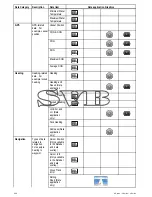
21.1 Radar application overview and
features
Radio Detection And Ranging (RADAR) is used to
detect the presence, distance and speed of objects
(known as ‘targets’). Radar works by transmitting
radio pulses, then detecting reflections of these
pulses (echoes) from objects in the area and
displaying the reflections as targets on your display.
Important:
Until you are familiar with interpreting
the radar display; every opportunity should be
taken to compare the radar screen patterns with
visual targets such as other vessels, buoys and
coastal structures. You should practise harbor and
coastal navigation during daylight hours and in
clear weather conditions.
D12207-3
6
7
1
4
5
2
3
1
0
8
9
Description
1
Radar status bar.
The status bar displays the following
information:
• Range
• Radar scanner serial number
• Gain mode
• Orientation
• Motion mode
• Range ring spacing
2
Onscreen controls (Touchscreen
multifunction displays only.)
3
Ship's Heading Marker (SHM)
4
Guard Zone
5
Radar status
6
Databox overlay
7
Waypoint
8
Safe zone ring
9
Range controls (Touchscreen multifunction
displays only.)
10
Ship's position
Additional functionality of the Radar application
includes:
• Color palettes.
• Adding AIS overlay.
• MARPA targets.
• VRM/EBL markers
Typically, your vessel’s position is at the center of the
display, and its dead ahead bearing is indicated by a
vertical heading line, known as the Ship’s Heading
Marker (SHM).
Note:
If the cursor is placed over the SHM, the
SHM will temporarily be removed to help placing
markers or acquiring targets etc.
Onscreen targets may be large, small, bright or faint,
depending on the size of the object, its orientation
and surface. If using a non-HD digital radome
scanner, strongest target returns are displayed in
yellow with weaker returns in 2 shades of blue. If
using a HD or SuperHD radar scanner, stronger
target returns show as different colors from a range
of 256 colors, providing better clarity.
Note:
Colors stated above refer to the default
color palette.
Be aware that the size of a target on screen is
dependent on many factors and may not necessarily
be proportional to its physical size. Nearby objects
may appear to be the same size as distant larger
objects.
With experience, the approximate size of different
objects can be determined by the relative size and
brightness of the echoes.
You should bear in mind that the size of each
onscreen target is affected by:
• The physical size of the reflecting object.
• The material from which the object is made.
Metallic surfaces reflect signals better than
non-metallic surfaces.
• Vertical objects such as cliffs reflect signals better
than sloping objects such as sandbanks.
• High coastlines and mountainous coastal
regions can be observed at longer radar ranges.
Therefore, the first sight of land may be a mountain
several miles inland from the coastline. Although
the coastline may be much nearer, it may not
appear on the radar until the vessel is closer to
shore.
• Some targets, such as buoys and small vessels
difficult to discern, because they do not present a
consistent reflecting surface as they bob and toss
about in the waves. Consequently these echoes
tend to fade and brighten, and at times disappear
momentarily.
• Buoys and small vessels resemble each other, but
vessels can often be distinguished by their motion.
Note:
A GPS receiver and a fast heading sensor
are required for MARPA operation, and to enable
radar/chart overlay.
312
a Series / c Series / e Series
Summary of Contents for c125
Page 2: ......
Page 14: ...14 a Series c Series e Series ...
Page 41: ...13 GPS receiver 14 Thermal camera 15 Wireless connection Planning the installation 41 ...
Page 48: ...48 a Series c Series e Series ...
Page 80: ...80 a Series c Series e Series ...
Page 118: ...118 a Series c Series e Series ...
Page 184: ...184 a Series c Series e Series ...
Page 188: ...188 a Series c Series e Series ...
Page 206: ...206 a Series c Series e Series ...
Page 228: ...228 a Series c Series e Series ...
Page 290: ...290 a Series c Series e Series ...
Page 310: ...310 a Series c Series e Series ...
Page 340: ...340 a Series c Series e Series ...
Page 374: ...374 a Series c Series e Series ...
Page 422: ...422 a Series c Series e Series ...
Page 436: ...436 a Series c Series e Series ...
Page 462: ...462 a Series c Series e Series ...
Page 463: ......
Page 464: ...www raymarine com ...
















































